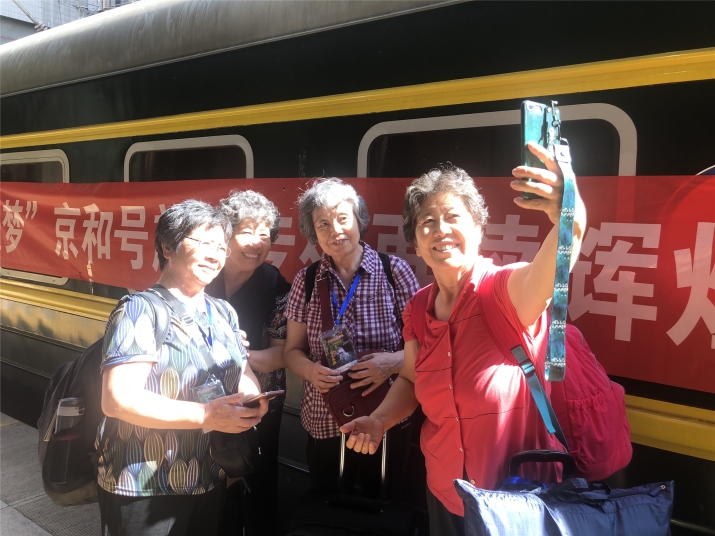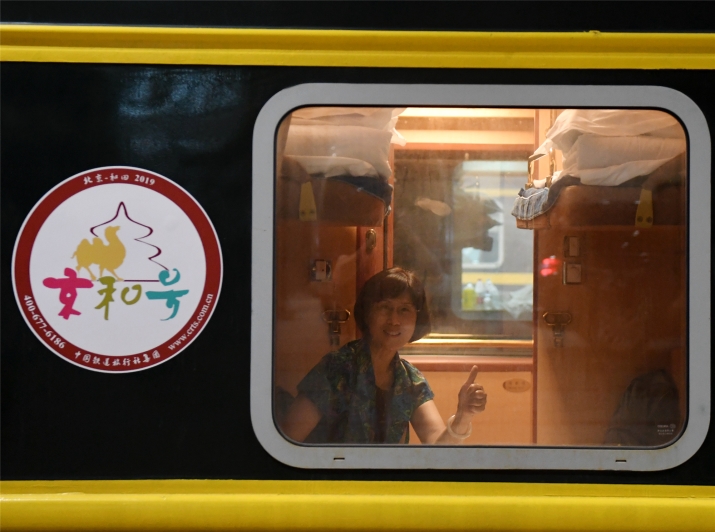|
||||||||||
| Home Nation World Business Opinion Lifestyle ChinAfrica Multimedia Columnists Documents Special Reports |
|
||||||||||
| Home Nation World Business Opinion Lifestyle ChinAfrica Multimedia Columnists Documents Special Reports |
| ChinAfrica |
| Railway's Diverse Appeal |
| Rail travel has emerged as the preferred choice for Chinese tourists, young and old |
| Hu Fan | VOL.11 October ·2019-10-01 |

Tourist take a group photo before boarding Jinghe tourist train in Beijing in August 2019 (COURTESY PHOTO)
It was a Friday evening in September and with no plan for the weekend, Zhang Xuan, a 25-year-old bank clerk, was lying in bed reading a book in his apartment in Beijing. He suddenly got the urge to go mountain hiking - possibly influenced by the contents of the book on national geography.
Quick as a flash, Zhang grabbed his phone and checked for a destination. His eyes fell on Taishan Mountain, one of China's most sacred mountains. Without hesitation, Zhang booked a train ticket and hotel online. On Saturday evening, he was on high-speed Train No.G203 heading for Tai'an in east China's Shandong Province - about 480 km from Beijing.
The three-hour journey flew past and after a good night's sleep at a local hotel, Zhang was up at the crack of dawn on Sunday, ready to summit the 1,524-meter mountain.
On the same day he returned to Beijing, stiff-legged but happy, at 7:30 p.m., and congratulated himself on a weekend well spent.
With China's well-developed network of high-speed railways, travel is no longer something that needs to be planned or prepared weeks ahead. For young people like Zhang, there is now no need to wait until the major holidays like National Day or Spring Festival to travel. To this generation, travel has become spontaneous.
"Many places I want to go are within a few hours by high-speed train from Beijing," Zhang told ChinAfrica, echoing the sentiments of his peers by noting that travel is so convenient now that it allows people to make instant travel plans, and thus broaden their horizons.

A traveler on Jinghe train (XINHUA)
Fast and fun
Zhang said more and more people choose to travel by high-speed train, thanks to its overwhelming advantages, compared to traditional trains and other means of transportation such as flying.
High-speed trains, although more expensive than conventional rail, have greatly reduced the travel time while providing a much better experience. Though many people questioned the increase of ticket prices when China started building high-speed railways about 10 years ago, high-speed trains have now been accepted by the majority of travelers, with statistics showing that in 2018, high-speed trains transported 2 billion passengers, accounting for over 60 percent of all train passengers in China.
"The price is acceptable, especially when compared to flying," said Zhang. His trip to Tai'an would have cost double had he flown, and factoring in time taken to get to the airport and onerous boarding procedures, flying domestically is not that much faster.
Zhang said the proximity of the station to the mountain was essential for him to make an impromptu trip. And this has become an important consideration for high-speed railway builders in China.
On December 25 last year, a high-speed railway line, hailed as the most beautiful scenic railway route in China, opened from Hangzhou, east China's Zhejiang Province, to Huangshan, east China's Anhui Province. The 265-km line connects five top and over 40 secondary national tourist resorts, including more than 10 national forest reserves. The trip is less than two hours and is a winner with travelers. More than half a year after its opening, it has brought major improvement to tourism along the line. In Jixi, one of the counties in Anhui the line passes through, both the number of visitors and overall tourism revenue increased by 10 percent year on year, according to Wu Xiaohui, Vice President of Huihang Gudao Tourism Development Co. Ltd. based in Jixi.
While the expanding network of high-speed railways is a privilege for tourists in east China, in the western areas, construction of high-speed railway lines has barely begun. A typical train from Beijing to northwest China's Xinjiang Uygur Autonomous Region, for example, takes one and a half days. This may be no problem for those with plenty of time on their hands.
Slow but sure
Cheng Rong, a 65-year-old retiree in Beijing, just returned from a trip to Xinjiang on a slow train. He called the trip "unforgettable" and has made plans with his friends to do the trip again.
It had been a decades-long dream of Cheng to travel to western part of China, but for a myriad of reasons, he had never taken the plunge. He decided to realize his dream one day when walking past a ticket office of China Railway Travel Service (CRTS), a travel agency that operates tourist trains.
"The tide has turned in China regarding how retirees should spend their days and traveling has become trendy," he said. However, he believed it is essential to choose the right way to travel due to physical considerations. "People like me have much time to travel and are basically healthy, but it is challenging for us to travel with conventional tour groups," he said, adding that his concerns include the tight schedule of these groups and the burden of carrying luggage around with him.
The train Cheng took, named Jinghe, operates between Beijing and Xinjiang's Hotan City over a span of 15 days and stops at around 10 cities. The schedule is flexible and luggage is taken care of by the crew.
Cheng had another reason for choosing the train. A railway worker before retirement, he has a strong attachment to the old green-color trains. "This color means a lot to me as an old railway worker," he said.
This feeling is not exclusive to railway workers. "There are many people who have a strong feeling for the green-color trains and want to revisit their past," Ge Hongjun, Taiwan Department Manager at CRTS, told ChinAfrica.
With pensioners as its main target customer demographic, CRTS understands well their needs regarding traveling. They have more time than employees and students and usually spend an average of six to seven days on a single trip. They also prefer to travel to multiple places in one trip and stay longer at each stop. For physical reasons, they feel comfortable to travel slowly.
Ge recalled that when the company was set up in 1984, they started with obsolete trains in poor conditions. Today, they provide a home-like traveling experience with luxurious cabins, bars, and special services such as singing and dancing performances. "As people's lifestyles improve, our customers are expecting more on a tourist train," Ge said.
The challenge is to improve the conditions of places where the train stops, as its destinations are mostly in less developed regions. Ge said it is difficult in some places even to find a dozen coaches that look the same to transfer passengers.
It is, however, one of the missions of tourist trains like Jinghe to change such conditions. Since its inaugural trip in 2015, Jinghe has made 11 trips, bringing some 5,500 passengers to destinations in west China, a region that is desperately in need of tourists.
"With tourists spending money in these places, we are contributing to local poverty reduction," said Ge.
(Comments to hufan@chinafrica.cn)
|
||||||||||||
| About Us | Contact Us | Advertise with Us | Subscribe |
| Copyright Beijing Review All rights reserved 京ICP备08005356号-5 京公网安备110102005860号 |